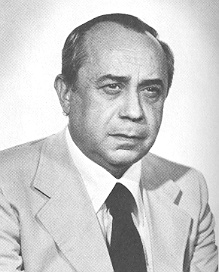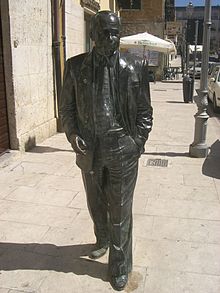Leonardo Sciascia
Leonardo Sciascia | |
|---|---|
 | |
| Member of theChamber of Deputies | |
| In office 20 June 1979 – 11 July 1983 | |
| Constituency | Rome |
| Member of the European Parliament forCentral Italy | |
| In office 17 July 1979 – 24 September 1979 | |
| Personal details | |
| Born | 8 January 1921 Racalmuto,Kingdom of Italy |
| Died | 20 November 1989(aged 68) Palermo,Italy |
| Political party | PCI(1975–1977) PR[1](1979–1984) |
| Residence(s) | Palermo, Sicily |
| Profession | Writer, novelist, journalist, political activist |
Leonardo Sciascia(Italian pronunciation:[leoˈnardoʃˈʃaʃʃa];8 January 1921 – 20 November 1989) was an Italian writer, novelist, essayist, playwright, and politician. Some of his works have been made into films, includingPorte Aperte(1990;Open Doors),Cadaveri Eccellenti(1976;Illustrious Corpses),Todo Modo(also 1976) andIl giorno della civetta(1968;The Day of the Owl). He is one of the greatest literary figures in theEuropean literatureof the 20th century.
Biography[edit]
This sectionneeds additional citations forverification.(August 2023) |
Sciascia was born inRacalmuto,Sicily, on 8 January 1921.[2]In 1935, his family moved toCaltanissetta,where Sciascia studied underVitaliano Brancati,who would become his model in writing and introduce him to French novelists. From Giuseppe Granata, futureCommunistmember of theItalian Senate,Sciascia learned about theFrench EnlightenmentandAmerican literature.In 1944, he married Maria Andronico, an elementary school teacher in Racalmuto. In 1948, his brother committed suicide, an event which profoundly impacted Sciascia.
Sciascia's first work,Favole della dittatura(Fables of the Dictatorship), a satire onfascism in Italy,was published in 1950.[3]This was followed in 1952 byLa Sicilia, il suo cuore(Sicily, its Heart), his first and only poetry collection, illustrated byEmilio Greco.The following year Sciascia won the Premio Pirandello, awarded by the Sicilian Region, for his essay "Pirandello e il pirandellismo"(" Pirandello and Pirandellism ").
In 1954, he began collaborating with literature andethnologymagazines published bySalvatore Sciasciain Caltanissetta. In 1956, he publishedLe parrocchie di Regalpetra(The Parishes of Regalpetra), an autobiographic novel inspired by his experience as an elementary school teacher in his home town. In the same year, he moved to teach in Caltanissetta, only to move again to Rome in 1957 where he struck up a lifelong friendship with Sicilian artist,Bruno Caruso.In the autumn of 1957, he publishedGli zii di Sicilia(Uncles of Sicily), which includes sharp views about themes such as the influence of the U.S. and ofcommunismin the world, and the 19th centuryunification of Italy.
After one year in Rome, Sciascia moved back to Caltanissetta, in Sicily. In 1961, he publishedIl giorno della civetta(The Day of the Owl), one of his most famous novels, about the Mafia, and in 1963, the historical novelIl consiglio d'Egitto(The Council of Egypt), set in 18th-centuryPalermo.After a series of essays, in 1965 he wrote the playL'onorevole(The Honorable), a denunciation of the complicities between government andthe mafia.Another political mystery novel is 1966'sA ciascuno il suo(To Each His Own).
The following year Sciascia moved to Palermo. In 1969, he began a collaboration withIl Corriere della Sera.That same year he published the playRecitazione della controversia liparitana dedicata ad A.D.(Recitation of liparitana dispute dedicated to A.D.), dedicated toAlexander Dubček.In 1971, Sciascia returned again to mystery withIl contesto(The Challenge), which inspiredFrancesco Rosi's movieCadaveri eccellenti(1976;Illustrious Corpses). The novel createdPolemics,due to its merciless portrait of Italian politics, as did his novelTodo modo(1974;One Way or Another), due to its description of Italy's Catholic clergy.
At the 1975 communal elections in Palermo, Sciascia ran as an independent within theItalian Communist Party(PCI) slate and was elected to the city council. In the same year, he publishedLa scomparsa di Majorana(The Disappearance of Majorana), dealing with the mysterious disappearance of scientistEttore Majorana.In 1977, he resigned from PCI, due to his opposition to any dealing with theDemocrazia Cristiana(Christian Democratic party). Later, he would be elected to the Italian and European Parliament with theRadical Party.
Sciascia's last works include the essay collectionCronachette(1985), the novelsPorte aperte(1987;Open Doors) andIl cavaliere e la morte(1988;The Horseman and Death). He died in June 1989 in Palermo.
Writing[edit]

A number of his books, such asThe Day of the Owl(Il giorno della civetta) andEqual Danger(Il contesto), demonstrate how the Mafia manages to sustain itself with the help of theanomieinherent in Sicilian life. He presented a forensic analysis of the kidnapping and assassination ofAldo Moro,a prominentChristian Democrat,in his bookThe Moro Affair.[4]
Sciascia's work is intricate and displays a longing for justice while attempting to show how corrupt Italian society had become and remains. His linking of politicians, intrigue, andthe Mafiagave him a high profile, which was very much at odds with his private self. This high profile resulted in his becoming widely disliked for his criticism ofGiulio Andreotti,then Prime Minister, for his lack of action to free Moro and answer the demands of theBrigate Rosse(Red Brigades).
In 1979, Sciascia was elected for the Radical Party in the House of Deputies and became a member of the committee of the House for the investigation into Moro's kidnapping, which stated that there was a certain amount of negligence on the part of the Christian Democrat Party in their stance that the state was bigger than a person, and that they would not swap Moro for 13 political prisoners, even though Moro himself had stated that the swapping of innocent people for political prisoners was a valid option in negotiations with terrorists. However, senior members of the party disagreed with this stance and were of the view that Moro had been drugged and tortured to utter these words. Out of this experience, Sciascia wrote an important book.
Sciascia wrote of his unique Sicilian experience, linking families with political parties, the treachery of alliances and allegiances, and the calling of favours that result in outcomes that do not benefit society, but those individuals who are in favor. His books are rarely characterized by a happy ending or by justice for the ordinary man. A prime example of this isEqual Danger(1973;Il Contesto),[5]in which the police's best detective is drafted to Sicily to investigate a spate of murders of judges. Focusing on the inability of authorities to handle such an investigation into the corruption, Sciascia's hero is finally thwarted.
His 1984 opus,Occhio di Capra[6](Goat's Eye), is a collection of Sicilian sayings and proverbs gathered from the area around his native village, to which he was intensely attached throughout his life.
Works[edit]


- Le favole della dittatura(1950)
- La Sicilia, il suo cuore(1952)
- Il fiore della poesia romanesca. Belli, Pascarella, Trilussa, Dell'Arco(1952)
- Pirandello e il Pirandellismo(1953)
- Le Parrocchie di Regalpetra(1st ed. 1956, 2nd augmented ed. 1963) (Salt in the Wound,trans. Judith Green (1969))
- Gli zii di Sicilia(1st ed. 1958, 2nd augmented ed. 1961) (Sicilian Uncles,trans. N.S. Thompson (1986)) – short stories
- Il Giorno della Civetta(1961) (Mafia Vendetta,trans. Archibald Colquhoun and Arthur Oliver (1963); republished asThe Day of the Owl(1984))
- Pirandello e la Sicilia(1961)
- Il consiglio d’Egitto(1963) (The Council of Egypt,trans. Adrienne Foulke (1966))
- Santo Marino(1963)
- Morte dell'inquisitore(1964) (Death of the Inquisitor,trans. Judith Green (1969);Death of an Inquisitor and other stories,trans. Ian Thomson (1990) (published with translations ofCronachette(1985) andLe strega e il capitano(1986))
- L'onorevole(1965)
- Jaki(1965)
- A ciascuno il suo(1966) (A Man's Blessing,trans. Adrienne Foulke (1968); republished asTo Each His Own(1992))
- Racconti siciliani(1966)
- Recitazione della controversia liparitana dedicata ad A.D.(1969)
- La corda pazza(1970)
- Atti relativi alla morte di Raymond Roussel(1971)
- Il contesto. Una parodia(1971) (Equal Danger,trans. Adrienne Foulke (1973))
- Il Mare Colore del Vino(1973) (The Wine-Dark Sea,trans. Avril Bardoni (1985)) – collected short stories
- Todo Modo(1974) (One Way or Another,trans. Adrienne Foulke (1977); Sacha Rabinovich (1987))
- La Scomparsa di Majorana(1975) (The Mystery of Majorana,trans. Sacha Rabinovich (1987))[7]
- I pugnalatori(1976)
- Candido, ovvero, un sogno fatto in Sicilia(1977) (Candido, or A Dream Dreamed in Sicily,trans. Adrienne Foulke (1979))
- L'affaire Moro(1st ed. 1978, 2nd augmented ed. 1983) (The Moro Affair,trans. Sacha Rabinovich (1987))
- Dalle parti degli infedeli(1979)
- Nero su nero(1979)
- Il teatro della memoria(1981)
- La sentenza memorabile(1982)
- Cruciverba(1983)
- Stendhal e la Sicilia(1984)
- Occhio di capra(1st ed. 1984, 2nd augmented ed. 1990)
- Cronachette(1985) (Little Chroniclestrans. Ian Thomson (1990) (published with translations ofMorte dell'inquisitore(1964) andLe strega e il capitano(1986))
- Per un ritratto dello scrittore da giovane(1985)
- La strega e il capitano(1987) (The Captain and the Witch,trans. Ian Thomson (1990) (published with translations ofMorte dell'inquisitore(1964) andCronachette(1985)
- 1912+1(1986) (1912 + 1,trans. Sacha Rabinovitch (1989))
- Porte Aperte(1987) (Open Doors,trans. Marie Evans (1991))
- Il Cavaliere e la Morte(1988) (The Knight and Death,trans. Joseph Farrell (1991))
- Alfabeto pirandelliano(1989)
- Fatti diversi di storia letteraria e civile(1989)
- Una storia semplice(1989) (A Straightforward Tale,trans. Joseph Farrell (1991);A Simple Story,trans. Howard Curtis (2010))
- A futura memoria (se la memoria ha un futuro)(1989)
Bibliography[edit]
In Italian on Sciascia's works[edit]
- Leonardo Sciascia,a cura di Sebastiano Gesù, Giuseppe Maimone Editore, Catania 1992
- Narratori siciliani del secondo dopoguerra,a cura di Sarah Zappulla Muscarà, Giuseppe Maimone Editore, Catania, 1990
- Cadaveri eccellenti,a cura di Sebastiano Gesù, Giuseppe Maimone Editore, Catania, 1992
- V. Fascia, F. Izzo, A. Maori,La memoria di carta: Bibliografia delle opere di Leonardo Sciascia,Edizioni Otto/Novecento, Milano, 1998
- V. Vecellio (a cura di),L'uomo solo: L'affaire Moro di Leonardo Sciascia,Edizioni La Vita Felice, Milano, 2002
- V. Vecellio,Saremo perduti senza la verità,Edizioni La Vita Felice, Milano, 2003
- G. Jackson,Nel labirinto di Sciascia,Edizioni La Vita Felice, Milano, 2004
- L. PalazzoloLeonardo Sciascia deputato radicale 1979–1983,Kaos edizioni, 2004
- L. Pogliaghi (a cura di),Giustizia come ossessione: forme della giustizia nella pagina di Leonardo Sciascia,Edizioni La Vita Felice, Milano, 2005
- M. D'Alessandra e S. Salis (a cura di),Nero su giallo: Leonardo Sciascia eretico del genere poliziesco,Edizioni La Vita Felice, Milano, 2006
- P. Milone,L'enciclopedia di Leonardo Sciascia: caos, ordine e caso: atti del 1○ ciclo di incontri (Roma, gennaio-aprile 2006),Quaderni Leonardo Sciascia, 11. Milano: La Vita Felice, 2007
- R. Martinoni,Troppo poco pazzi: Leonardo Sciascia nella libera e laica Svizzera(Collana Sciascia scrittore europeo, I, in collaboration with Amici di Leonardo Sciascia) Leo S. Olschki editore, Firenze: Leo S. Olschki editore, 2011
- I. Thomson,Una conversazione a Palermo con Leonardo Sciascia,Rubbetino Editore, 2022
In English on Sciascia's works[edit]
- Giffuni, Cathe (Spring–Summer 1989). "A Bibliography of the Mystery Writings of Leonardo Sciascia".Clues: A Journal of Detection.10(1): 75–87.
- L. Sciascia, M. Padovani,Sicily as Metaphor,Marlboro: Marlboro Press, 1994
- J. Farrell,Leonardo Sciascia,Writers of Italy. Edinburgh: Edinburgh University Press, 1995
- G. Ania,Fortunes of the Firefly: Sciascia's Art of Detection,Market Harborough: University Texts, 1996
- R. Glynn,Contesting the Monument: The Anti-Illusionist Italian Historical Novel,Italian perspectives, 10. Leeds, England: Northern Universities Press, 2005
- J. Cannon.The Novel As Investigation: Leonardo Sciascia, Dacia Maraini, and Antonio Tabucchi,Toronto Italian studies. Toronto: University of Toronto Press, 2006
References[edit]
- ^Lanfranco Palazzolo (1 January 2004).Leonardo Sciascia deputato radicale 1978–1983.Kaos.
- ^Michela Montante (Winter 1991). "Leonardo Sciascia: The Writer".World Literature Today.65(1): 65–68.doi:10.2307/40146124.JSTOR40146124.
- ^"Leonardo Sciascia".Encyclopædia Britannica.8 April 2024.
- ^The Moro Affair and The Mystery of Majorana(English and Italian; Hardcover ed.). Carcanet Press. 1 January 1987.ISBN978-0856357008.
- ^Sciascia, Leonardo (1973).Equal Danger(First ed.). Harper & Row.ISBN978-0060138097.
- ^Sciascia, Leonardo (1984).Occhio di capra.Torino: Einaudi.ISBN9788806057756.OCLC797364283.
- ^The book focuses on the mysterious disappearance of Italian physicistEttore Majorana.Sciascia summarizes the results of the investigations, examines the facts and the documents concerning Majorana, and suggests a theory about the scientist's fate, rejecting the "suicide" hypothesis.
External links[edit]
- (in Italian)Associazione Amici di Leonardo Sciascia(Friends of Leonardo Sciascia Society)
- (in Italian)Fondazione Leonardo Sciascia(Leonardo Sciascia Foundation)
- Leonardo Sciascia
- 1921 births
- 1989 deaths
- 20th-century Italian novelists
- 20th-century male writers
- Antimafia
- Deputies of Legislature VIII of Italy
- Historians of the Sicilian Mafia
- Italian deists
- Italian communists
- Organized crime novelists
- People from Racalmuto
- Radical Party (Italy) politicians
- Writers from the Province of Agrigento
- Politicians from the Province of Agrigento
- Deaths from multiple myeloma
